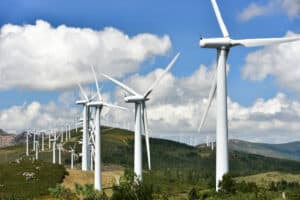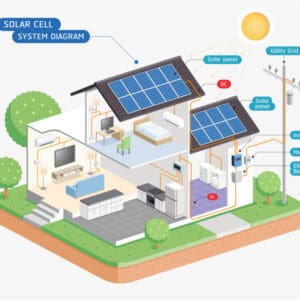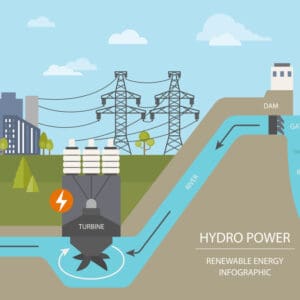In the pursuit of sustainable and eco-friendly power solutions, the term “cheap renewable energy” has become a focal point, guiding the exploration of various sources beyond traditional hydroelectric power.
Among these, solar energy and onshore wind power emerge as front-runners, offering not only affordability but also a promise of efficiency in the renewable energy sector.
Each of these alternatives boasts significant advantages and, inevitably, faces certain challenges.
Delving into the specifics of these options is essential for understanding their potential to redefine the landscape of cost-effective, renewable energy.
This comprehensive examination aims to shed light on the nuances of solar energy and onshore wind power, illustrating their roles as pivotal components of the quest for accessible and cheap renewable energy solutions.
What is Renewable Energy?
Renewable energy is derived from natural processes that are continuously replenished.
These sources, such as sunlight, wind, and water, have a much lower environmental impact compared to fossil fuels.
They don't produce greenhouse gases or release harmful pollutants, making them a cleaner, more sustainable choice.

The 7 Economic Benefits of Cheap Renewable Energy
Cheap renewable energy offers a wide array of economic benefits that extend beyond just environmental considerations.
These benefits have the potential to positively impact various sectors of the economy and promote long-term sustainable growth.
Some of the key economic advantages of cheap renewable energy include:
- Job Creation: The renewable energy sector creates jobs and decreases unemployment rates in local communities as it requires skilled workers for manufacturing, installation, operation, and maintenance.
- Energy Cost Stability: Renewable energy sources like solar, wind, and hydropower have low fuel costs and are not affected by fossil fuel price changes. This ensures stable energy expenses for homes and businesses.
- Reduced Energy Import Dependence: Investing in cheap renewable energy reduces reliance on imported fossil fuels, improving energy security and reducing exposure to global energy market volatility and geopolitical tensions.
- Diversification of Energy Portfolio: A varied energy mix with renewables boosts a country's energy resilience, enabling alternative sources to meet demand during supply disruptions or price shocks.
- Stimulated Economic Growth: Investing in renewable energy boosts the economy by driving demand for goods and services in various sectors such as manufacturing, construction, and research and development.
- Private Sector Investment: As renewable energy costs decrease, private sector interest grows, fostering innovation and benefiting both the sector and the economy.
- Infrastructure Development: Renewable energy projects need infrastructure like transmission lines, energy storage, and smart grids. These investments also benefit other sectors and overall infrastructure development.
Types of Cheap Renewable Energy Sources

Onshore wind
Onshore wind is cheaper than offshore wind. In 2015, onshore wind cost $80/MWh. It was predicted that global installations would increase by 10% by 2019. Onshore wind provides 7% of global electricity and had 93 GW of new installations last year.
The goal is 743 GW by 2020. The UK, China, and Germany have the most offshore installations. The London Array, an offshore project, has a capacity of 0.6 GW and cost EUR2.5 billion. It powers 1.7 million Britons.
Onshore wind is a cost-effective way to generate electricity in the UK, thanks to its affordability and ample wind resources. According to BVG Associates, the cost breakdown per megawatt-hour shows that onshore wind is budget-friendly, despite initial costs.
With advancements in technology, onshore wind capacity has grown to over 60 gigawatts globally and is expected to reach 750 GW by 2022, making it a cheap and eco-friendly power source.
Wind power is becoming popular worldwide due to its low cost, with countries like Denmark leading the way. The United States has seen significant growth in wind energy, now accounting for a fifth of electricity generation.
This shift towards renewables is projected to surpass coal in 2020, highlighting wind's role as a cost-efficient energy source.

Solar Power
Renewable energy costs, including solar projects, fell 85% in the past decade. With battery storage costs down 70%, solar and wind power is now cheaper than coal. Australia uses solar energy for water and electricity, benefiting homes and bigger projects.
Governments offer incentives for solar power due to low costs and environmental benefits. Solar becomes economically viable when carbon emissions are priced, as seen in Californian plants switching to photovoltaic technology.
Financing is a problem for the $6 billion Blythe parabolic trough project in California. Despite a $2.1 billion loan guarantee from the US Department of Energy and a power purchase agreement, it had to change to a solar PV plant because of financial challenges.
Solar PV is a viable option for electricity generation in homes in developing countries. It will contribute over 30% of new capacity in the next decade. Innovation, such as solar roof shingles and skylights, is crucial for overcoming challenges.
Morocco's Noor-Ouarzazate CSP plant is a global solar power leader. It has a 510 MWe capacity and costs $0.19/kWh, showcasing solar technology's scale and innovation. Its parabolic trough collectors for steam production set an industry standard.
Renewable energy costs are dropping, making it competitive with coal power by 2020. This change promotes economic growth and encourages the adoption of sustainable energy.

Hydroelectric Power
Hydroelectric power, leveraging dams on streams or lakes, is a cost-effective and clean energy source. These facilities harness water from elevated pools, directing it through turbines to generate electricity.
Although initial costs vary, with traditional hydro systems being more affordable and greenfield or upgrade projects pricier, hydropower remains cheaper than other renewables. It's also beneficial for domestic use.
However, environmental concerns exist, notably that dams can increase greenhouse gas emissions due to organic decomposition in water, contributing to global CO2 and CH4 levels.
Past studies highlighted hydropower's potential to emit more greenhouse gases than coal plants, attributing four percent of global emissions to it.
Despite rising costs, hydropower's price per kWh remains the lowest among renewables, as per a 2019 IRENA study, making it a viable, yet imperfect, energy solution.

The Future of Renewable Energy
The future of renewable energy holds promising advancements that will reshape the global energy landscape, drive sustainability, and address the challenges posed by climate change.
Here are some key trends and possibilities that could shape the future of renewable energy:
- Technological Innovations: Research and development in renewable energy will improve efficiency and affordability. Advances in materials, energy storage, and grid integration will enhance reliability, making renewables a viable replacement for fossil fuels.
- Energy Storage Revolution: New energy storage tech will solve solar and wind power's intermittency, allowing smooth integration into the grid for a reliable energy supply.
- Decentralization and Microgrids: The rise of decentralized energy systems and microgrids will empower local communities and businesses to generate, store, and distribute their own renewable energy. This approach enhances energy resilience, reduces transmission losses, and fosters energy independence.
- Hybrid Solutions: Combining multiple renewable energy sources, such as solar, wind, hydro, and geothermal, in hybrid systems can provide a consistent and reliable energy supply. These integrated systems optimize energy production by leveraging the strengths of each source.
- Offshore Wind and Deepwater Solar: Offshore wind farms and floating solar arrays in deep ocean waters have great potential for renewable energy. They harness stronger winds and sunlight, expanding sustainable power production.
- Electrification of Sectors: The electrification of sectors like transportation, heating, and industry will increase the demand for renewable electricity. Electric vehicles, heat pumps, and electric industrial processes will drive the need for expanded renewable energy capacity.
Conclusion
As I explore renewable energy, I feel thrilled and optimistic. It's vital for our planet and offers economic benefits like sustainable growth, jobs, and stability in energy markets.
When looking at onshore wind, solar power, and hydroelectricity, it's interesting to see their different strengths and challenges.
Onshore wind is growing quickly and becoming cheaper, solar power is innovating and becoming more affordable, and hydroelectricity uses flowing water to generate power and is cost-effective.
Source:
https://www.sciencedirect.com/science/article/pii/S2211467X2200133X

